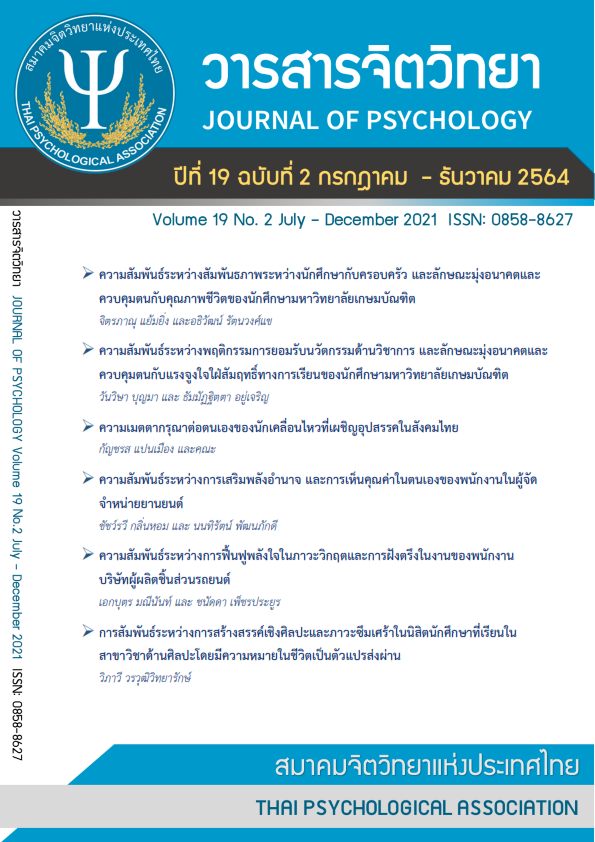ความสัมพันธ์ระหว่างการสร้างสรรค์เชิงศิลปะและภาวะซึมเศร้าในนิสิตนักศึกษาที่เรียนในสาขาวิชาด้านศิลปะโดยมีความหมายในชีวิตเป็นตัวแปรส่งผ่าน
คำสำคัญ:
การสร้างสรรค์เชิงศิลปะ, ความหมายในชีวิต, ภาวะซึมเศร้า, นิสิตนักศึกษาด้านศิลปะบทคัดย่อ
การวิจัยนี้มีวัตถุประสงค์ เพื่อศึกษาความสัมพันธ์ระหว่างการสร้างสรรค์เชิงศิลปะ ความหมายในชีวิตและภาวะซึมเศร้า กลุ่มตัวอย่าง เป็นนิสิตนักศึกษาศิลปะ จำนวน 311 คน อายุเฉลี่ยเท่ากับ 20.53 ปี เครื่องมือที่ใช้ในการวิจัย ได้แก่ มาตรวัดสมรรถนะการสร้างสรรค์ของเอปสไตน์ฉบับภาษาไทย มาตรวัดความหมายในชีวิต มาตรวัดด้านย่อยภาวะซึมเศร้าของมาตรวัดความเครียด ความวิตกกังวล ภาวะซึมเศร้าฉบับ 42 ข้อ วิเคราะห์ข้อมูลโดยวิเคราะห์การถดถอยตามแนวทางของ Baron และ Kenny (1986) ผลการวิจัยพบว่า ความหมายในชีวิตมีบทบาทเป็นตัวแปรส่งผ่านแบบสมบูรณ์ในความสัมพันธ์ระหว่างการสร้างสรรค์เชิงศิลปะและภาวะซึมเศร้าในนิสิตนักศึกษาด้านศิลปะ ผลการวิจัยนี้บ่งชี้ว่านิสิตนักศึกษาที่มีการสร้างสรรค์เชิงศิลปะหากพวกเขามีความหมายในชีวิตสูงพวกเขาก็จะมีแนวโน้มของอาการของภาวะซึมเศร้าต่ำ
เอกสารอ้างอิง
อรัญญา ตุ้ยคำภีร์. (2544). การพัฒนามาตรวัดความมุ่งหวังในชีวิตนักศึกษาไทย. วารสารสุขภาพจิตแห่งประเทศไทย, 9(1), 18-26.
อรัญญา ตุ้ยคำภีร์. (2554). จิตบำบัดแนวความหมายในชีวิต Logotherapy (พิมพ์ครั้งที่ 2). โรงพิมพ์แห่งจุฬาลงกรณ์มหาวิทยาลัย.
Baron, R. M., & Kenny, D. A. (1986). The moderator–mediator variable distinction in social psychological research: Conceptual, strategic, and
statistical considerations. Journal of Personality and Social Psychology, 51(6), 1173-1182.
Blackburn, L., & Owens, G. P. (2015). The effect of self efficacy and meaning in life on posttraumatic stress disorder and depression severity
among veterans. Journal of Clinical Psychology, 71(3), 219-228.
Crumbaugh, J. C., & Maholick, L. T. (1964). An experimental study in existentialism: The psychometric approach to Frankl's concept of noogenic
neurosis. Journal of Clinical Psychology, 20(2), 200-207.
Epstein, R. (1996). Capturing creativity. Psychology Today, 29(4), 41-43.
Epstein, R., & Phan, V. (2012). Which competencies are most important for creative expression?. Creativity Research Journal, 24(4), 278-282.
Epstein, R., Schmidt, S. M., & Warfel, R. (2008). Measuring and training creativity competencies: Validation of a new test. Creativity Research
Journal, 20(1), 7-12.
Feist, G. J. (1998). A meta-analysis of personality in scientific and artistic creativity. Personality and Social Psychology Review, 2(4), 290-309.
Frankl, V. E. (1963). Man's search for meaning: An introduction to logotherapy. Pocket.
Guilford, J. P. (1967). The nature of human intelligence. McGraw-Hill.
Jamison, K. R. (1989). Mood disorders and patterns of creativity in British writers and artists. Psychiatry, 52(2), 125-134.
Kang, K., Im, J., Kim, H., Kim, S., Song, M., & Sim, S. (2009). The effect of logotherapy on the suffering, finding meaning, and spiritual well-being
of adolescents with terminal cancer. Journal of Current Directions in Psychological Science, 312-319.
Kersting, K. (2003). What exactly is creativity. Monitor on Psychology, 34(10), 1-40.
Lovibond, S. H., & Lovibond, P. F. (1995). Manual for the Depression Anxiety Stress Scales (2nd ed.). Psychology Foundation.
MacKinnon, D. W. (1962). The nature and nurture of creative talent. American Psychologist, 17, 484–495.
Phillips, W. M. (1980). Purpose in life, depression, and locus of control. Journal of Clinical Psychology, 36(3), 661-667.
Silvia, P. J., & Kimbrel, N. A. (2010). A dimensional analysis of creativity and mental illness: Do anxiety and depression symptoms predict
creative cognition, creative accomplishments, and creative self-concepts?. Psychology of Aesthetics, Creativity, and the Arts, 4(1), 2-10.
Sternberg, R. J. (2006). The nature of creativity. Creativity Research Journal, 18(1), 87-98.
Torrance, E. P. (1988). The nature of creativity as manifest in its testing. The nature of creativity, 43-75.
Waddell, C. (1998). Creativity and mental illness: is there a link?. The Canadian Journal of Psychiatry, 43(2), 166-172.
เผยแพร่แล้ว
รูปแบบการอ้างอิง
ฉบับ
ประเภทบทความ
สัญญาอนุญาต
ลิขสิทธิ์ (c) 2021 สมาคมจิตวิทยาแห่งประเทศไทย

อนุญาตภายใต้เงื่อนไข Creative Commons Attribution-NonCommercial-NoDerivatives 4.0 International License.
บทความที่ได้รับการตีพิมพ์เป็นลิขสิทธิ์ของสมาคมจิตวิทยาแห่งประเทศไทย
ข้อความที่ปรากฎในบทความแต่ละเรื่องในวารสารวิชาการเล่มนี้เป็นความคิดเห็นส่วนตัวของผู้เขียนแต่ละท่านไม่เกี่ยวข้องกับสมาคมจิตวิทยาแห่งประเทศไทย แต่อย่างใด ความรับผิดชอบองค์ประกอบทั้งหมดของบทความแต่ละเรื่องเป็นของผู้เขียนแต่ละท่าน หากมีความผิดพลาดใด ๆ ผู้เขียนแต่ละท่านจะรับผิดชอบบทความของตนเองแต่ผู้เดียว






